Order-6-4 square honeycomb
| Order-4-6 square honeycomb | |
|---|---|
| Type | Regular honeycomb |
| Schläfli symbol | {4,6,4} |
| Coxeter diagrams | |
| Cells | {4,6} 
|
| Faces | {4} |
| Edge figure | {4} |
| Vertex figure | {6,4} |
| Dual | self-dual |
| Coxeter group | [4,6,4] |
| Properties | Regular |
In the geometry of hyperbolic 3-space, the order-6-4 square honeycomb (or 4,6,4 honeycomb) a regular space-filling tessellation (or honeycomb) with Schläfli symbol {4,6,4}.
Geometry
All vertices are ultra-ideal (existing beyond the ideal boundary) with four order-6 square tilings existing around each edge and with an order-4 hexagonal tiling vertex figure.
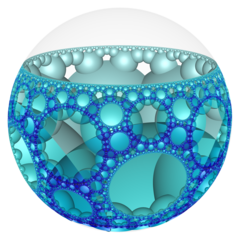 Poincaré disk model |
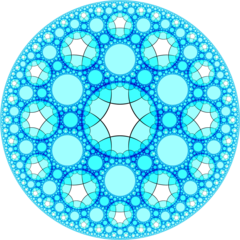 Ideal surface |
Related polytopes and honeycombs
It a part of a sequence of regular polychora and honeycombs {p,6,p}:
Order-6-5 hexagonal honeycomb
| Order-6-5 pentagonal honeycomb | |
|---|---|
| Type | Regular honeycomb |
| Schläfli symbol | {5,6,5} |
| Coxeter diagrams | |
| Cells | {5,6} 
|
| Faces | {5} |
| Edge figure | {5} |
| Vertex figure | {6,5} |
| Dual | self-dual |
| Coxeter group | [5,6,5] |
| Properties | Regular |
In the geometry of hyperbolic 3-space, the order-6-5 pentagonal honeycomb (or 5,6,5 honeycomb) a regular space-filling tessellation (or honeycomb) with Schläfli symbol {5,6,5}.
All vertices are ultra-ideal (existing beyond the ideal boundary) with five order-6 pentagonal tilings existing around each edge and with an order-5 hexagonal tiling vertex figure.
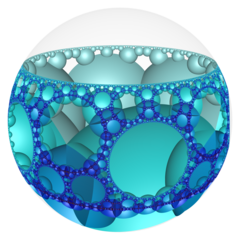 Poincaré disk model |
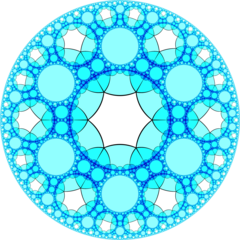 Ideal surface |
Order-6-6 hexagonal honeycomb
| Order-5-6 hexagonal honeycomb | |
|---|---|
| Type | Regular honeycomb |
| Schläfli symbols | {6,6,6} {6,(6,3,6)} |
| Coxeter diagrams | |
| Cells | {6,6} 
|
| Faces | {6} |
| Edge figure | {6} |
| Vertex figure | {6,6} {(6,3,6)} |
| Dual | self-dual |
| Coxeter group | [6,5,6] [6,((6,3,6))] |
| Properties | Regular |
In the geometry of hyperbolic 3-space, the order-6-6 hexagonal honeycomb (or 6,6,6 honeycomb) is a regular space-filling tessellation (or honeycomb) with Schläfli symbol {6,6,6}. It has six order-6 hexagonal tilings, {6,6}, around each edge. All vertices are ultra-ideal (existing beyond the ideal boundary) with infinitely many hexagonal tilings existing around each vertex in an order-6 hexagonal tiling vertex arrangement.
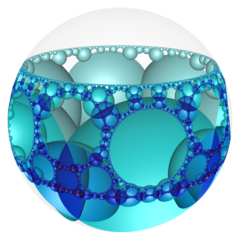 Poincaré disk model |
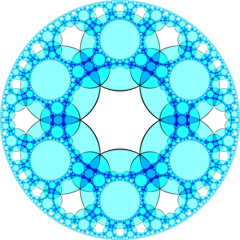 Ideal surface |
It has a second construction as a uniform honeycomb, Schläfli symbol {6,(6,3,6)}, Coxeter diagram, ![]()
![]()
![]()
![]()
![]() , with alternating types or colors of cells. In Coxeter notation the half symmetry is [6,6,6,1+] = [6,((6,3,6))].
, with alternating types or colors of cells. In Coxeter notation the half symmetry is [6,6,6,1+] = [6,((6,3,6))].
Order-6-infinite apeirogonal honeycomb
| Order-6-infinite apeirogonal honeycomb | |
|---|---|
| Type | Regular honeycomb |
| Schläfli symbols | {∞,6,∞} {∞,(6,∞,6)} |
| Coxeter diagrams | |
| Cells | {∞,6} 
|
| Faces | {∞} |
| Edge figure | {∞} |
| Vertex figure | |
| Dual | self-dual |
| Coxeter group | [∞,6,∞] [∞,((6,∞,6))] |
| Properties | Regular |
In the geometry of hyperbolic 3-space, the order-6-infinite apeirogonal honeycomb (or ∞,6,∞ honeycomb) is a regular space-filling tessellation (or honeycomb) with Schläfli symbol {∞,6,∞}. It has infinitely many order-6 apeirogonal tiling {∞,6} around each edge. All vertices are ultra-ideal (existing beyond the ideal boundary) with infinitely many order-6 apeirogonal tilings existing around each vertex in an infinite-order square tiling vertex arrangement.
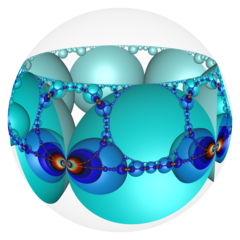 Poincaré disk model |
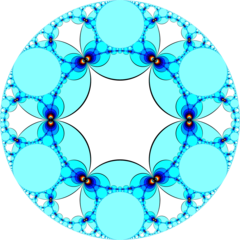 Ideal surface |
It has a second construction as a uniform honeycomb, Schläfli symbol {∞,(6,∞,6)}, Coxeter diagram, ![]()
![]()
![]()
![]()
![]()
![]() , with alternating types or colors of cells.
, with alternating types or colors of cells.
See also
- Convex uniform honeycombs in hyperbolic space
- List of regular polytopes
- Infinite-order dodecahedral honeycomb
References
- Coxeter, Regular Polytopes, 3rd. ed., Dover Publications, 1973. ISBN 0-486-61480-8. (Tables I and II: Regular polytopes and honeycombs, pp. 294–296)
- The Beauty of Geometry: Twelve Essays (1999), Dover Publications, LCCN 99-35678, ISBN 0-486-40919-8 (Chapter 10, Regular Honeycombs in Hyperbolic Space) Table III
- Jeffrey R. Weeks The Shape of Space, 2nd edition ISBN 0-8247-0709-5 (Chapters 16–17: Geometries on Three-manifolds I, II)
- George Maxwell, Sphere Packings and Hyperbolic Reflection Groups, JOURNAL OF ALGEBRA 79,78-97 (1982) [1]
- Hao Chen, Jean-Philippe Labbé, Lorentzian Coxeter groups and Boyd-Maxwell ball packings, (2013)[2]
- Visualizing Hyperbolic Honeycombs arXiv:1511.02851 Roice Nelson, Henry Segerman (2015)
External links
- John Baez, Visual insights: {7,3,3} Honeycomb (2014/08/01) {7,3,3} Honeycomb Meets Plane at Infinity (2014/08/14)
- Danny Calegari, Kleinian, a tool for visualizing Kleinian groups, Geometry and the Imagination 4 March 2014. [3]
